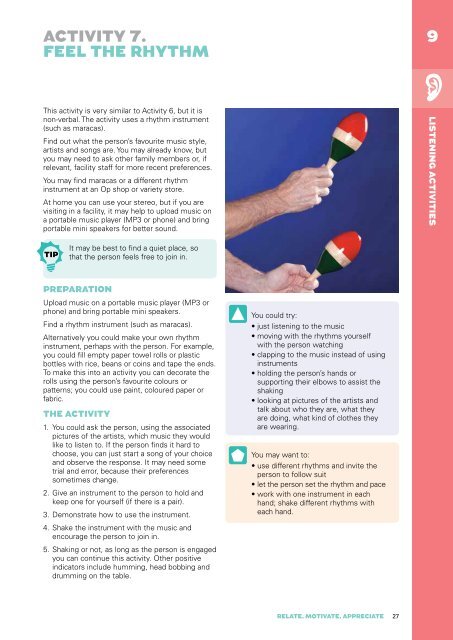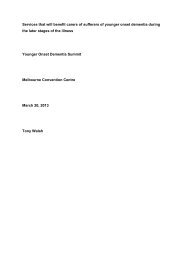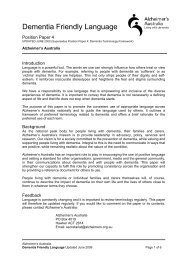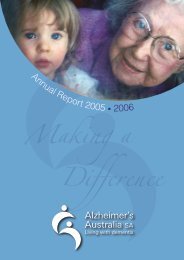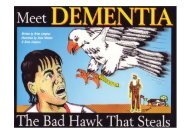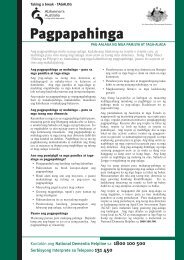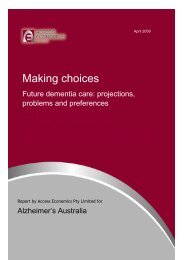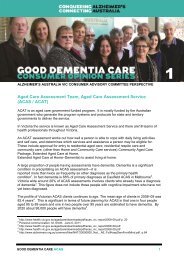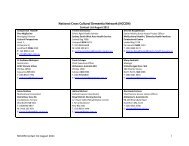RELATE, MOTIVATE, APPRECIATE - Alzheimer's Australia
RELATE, MOTIVATE, APPRECIATE - Alzheimer's Australia
RELATE, MOTIVATE, APPRECIATE - Alzheimer's Australia
Create successful ePaper yourself
Turn your PDF publications into a flip-book with our unique Google optimized e-Paper software.
EASY 0PTI0N<br />
Activity 7.<br />
Feel the rhythm<br />
9<br />
This activity is very similar to Activity 6, but it is<br />
non-verbal. The activity uses a rhythm instrument<br />
(such as maracas).<br />
Find out what the person’s favourite music style,<br />
artists and songs are. You may already know, but<br />
you may need to ask other family members or, if<br />
relevant, facility staff for more recent preferences.<br />
You may find maracas or a different rhythm<br />
instrument at an Op shop or variety store.<br />
At home you can use your stereo, but if you are<br />
visiting in a facility, it may help to upload music on<br />
a portable music player (MP3 or phone) and bring<br />
portable mini speakers for better sound.<br />
LISTENING ACTIVITIES<br />
It may be best to find a quiet place, so<br />
that the person feels free to join in.<br />
Preparation<br />
Upload music on a portable music player (MP3 or<br />
phone) and bring portable mini speakers.<br />
Find a rhythm instrument (such as maracas).<br />
Alternatively you could make your own rhythm<br />
instrument, perhaps with the person. For example,<br />
you could fill empty paper towel rolls or plastic<br />
bottles with rice, beans or coins and tape the ends.<br />
To make this into an activity you can decorate the<br />
rolls using the person’s favourite colours or<br />
patterns; you could use paint, coloured paper or<br />
fabric.<br />
The activity<br />
1. You could ask the person, using the associated<br />
pictures of the artists, which music they would<br />
like to listen to. If the person finds it hard to<br />
choose, you can just start a song of your choice<br />
and observe the response. It may need some<br />
trial and error, because their preferences<br />
sometimes change.<br />
2. Give an instrument to the person to hold and<br />
keep one for yourself (if there is a pair).<br />
3. Demonstrate how to use the instrument.<br />
4. Shake the instrument with the music and<br />
encourage the person to join in.<br />
5. Shaking or not, as long as the person is engaged<br />
you can continue this activity. Other positive<br />
indicators include humming, head bobbing and<br />
drumming on the table.<br />
M0RE DIFFICULT<br />
0PTI0N<br />
EASY 0PTI0N<br />
M0RE DIFFICULT<br />
0PTI0N<br />
You could try:<br />
• just listening to the music<br />
• moving with the rhythms yourself<br />
with the person watching<br />
• clapping to the music instead of using<br />
instruments<br />
• holding the person’s hands or<br />
supporting their elbows to assist the<br />
shaking<br />
• looking at pictures of the artists and<br />
talk about who they are, what they<br />
are doing, what kind of clothes they<br />
are wearing.<br />
You may want to:<br />
• use different rhythms and invite the<br />
person to follow suit<br />
• let the person set the rhythm and pace<br />
• work with one instrument in each<br />
hand; shake different rhythms with<br />
each hand.<br />
<strong>RELATE</strong>, <strong>MOTIVATE</strong>, <strong>APPRECIATE</strong> 27


